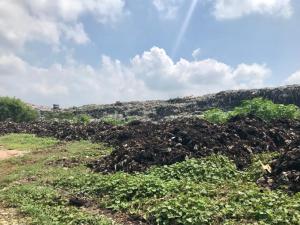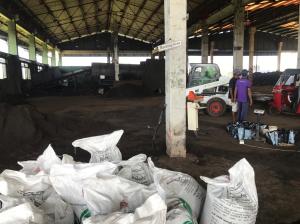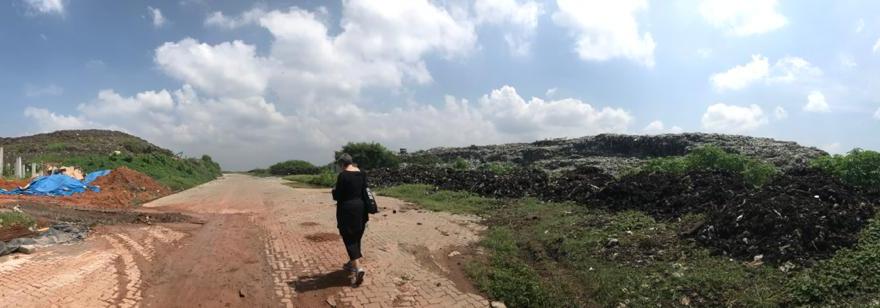Location: Mihisaru Wiyamana – Resource Management Centre Karadiyana, Sri Lanka
Time period: November 2019
In November 2019, the r4d team in Sri Lanka with SNSF Senior Researcher and faculty member of the University of Lausanne Dr Pia Hollenbach, visited a ‘new’ garbage dump site in Karadiyana or ‘Mihisaru Wiyamana – Resource Management Centre Karadiyana’. The project is a public-private partnership with Fairway Waste Management Private Ltd, a subsidiary to Fairway Holdings.
The post has been written with observations and notes taken during a conversation with the site manager, Mr Dhanuka Wijerathna.
When the Waste Management Authority (WMA) took over the Karadiyana site in 2010, the dumpsite is not the best place for a waste management project given the number of surrounding water bodies. However, there has been illegal dumping and historic/inherited waste since 1980 that the site was in need of management. Mr Wijerathna informs us that the ground and surface water around the dumpsite have already been polluted upon taking on the site, however, since then they have stopped accepting medical/toxic and clinical waste in an effort to help minimise any further damage to the area. The Karadiyana site also has a 500m radius as an environmental monitoring area where there are regular mosquito/insect and odour control programmes.

The Karadiyana site is the second-largest dumpsite in the province and receives 550 metric tonnes of waste a day from seven local authorities including:
- Moratuwa Municipal Council
- Dehiwala – Mount Lavinia Municipal Council
- Sri Jayawardenepura Kotte Municipal Council
- Urban Council Maharagama
- Kesbewa Urban Council
- Homagama Pradeshiya Sabha
The waste collected is from a population of approximately 1.5-2 million people and nearly 250 vehicles come in daily. The waste composition is mostly mixed and since 2014, the WMA called for the sorting of waste at both household and collection-level through awareness programmes and since 2015, the site has been able to produce biofertilizer through compositing. What began with 30 MT of fertiliser is now amounting to nearly 150 MT and there is an irregular demand from the Maldives for 200 MT of composted fertilizer. However, Mr Wijerathna informs us that there still isn’t an overwhelming demand for fertilizer made from municipal solid waste (MSW) due to the not only the competition from the private sector fertilizer marker but also the bad reputation compost fertilizer gained in 2010 due to being of mixed, unsorted waste.
The WMA was able to encourage and influence the sorting of waste by implementing a price control on the tipping fee. Thereby the WMA increased the fee for mixed waste to approximately LKR 1,000 and reduced the tipping fee to LKR 250 for organic/separated waste. This practice has resulted in the initial organic/sorted waste composition increasing from 5-10 MT daily to nearly 250 MT. The tipping fee is also one of the largest contributors to Karadiyana’s ‘income’.
Mr Wijerathna informs that of the total 550 MT waste collected, nearly 60% being of organic waste composition, and about 10% being mixed in with other waste. He goes on to say that there can be more efficient processes and the waste-to-energy project and composting facility implemented on-site would greatly benefit if the organic waste composition increases and is sorted.

The Karadiyana site underwent analysis in 2016 after the infamous collapse of the Meethotamulla garbage dump landslide that resulted in 32 deaths. Given that the site already came with a significant quantity of inherited waste, the National Building Research Organisation (NBRO) suggested that Karadiyana either, a) removing the existing waste to another site to prevent any landslides like in the case of Meethotamulla or b) stabilise the existing mountains, stop the piling of garbage on the mountains and work towards improving soil covering etc. Given that the option a) was not feasible and not economical, the officials at the Karadiyana site focused on the option b). Mr Wijerathna also hopes to kick start the waste-to-energy facility that is done in partnership with Fairway Holdings. The waste-to-energy will include a biogas unit and an incineration facility. Eventually, the site also hopes to build a training centre that would bring a new generation of experts in the waste-to-energy industry.
Story and pictures by: Senashia Ekanayake




2 thoughts on “Field Visit to Karadiyana Dumpsite”